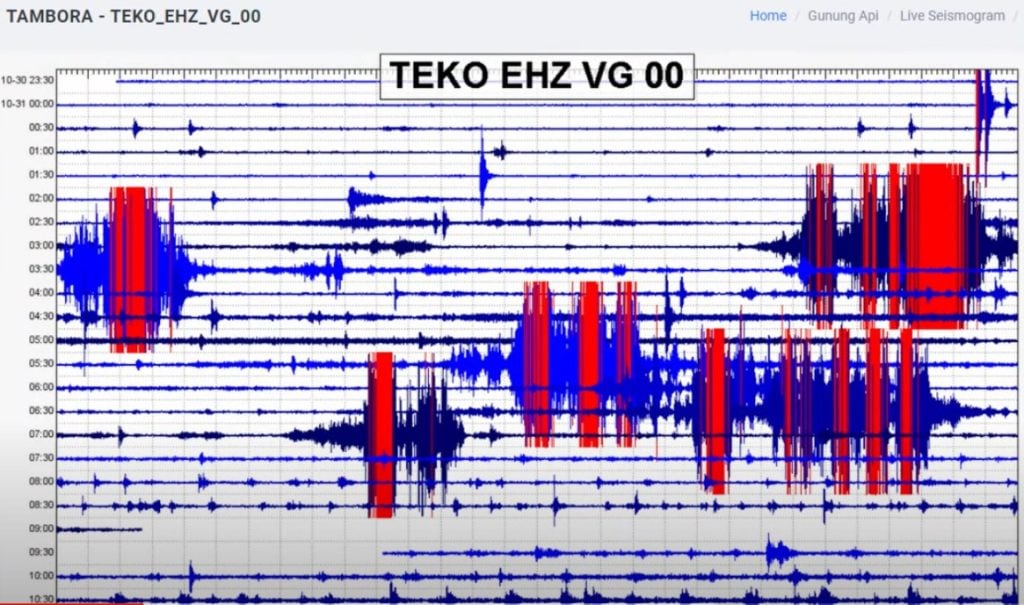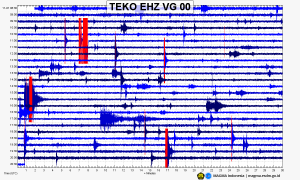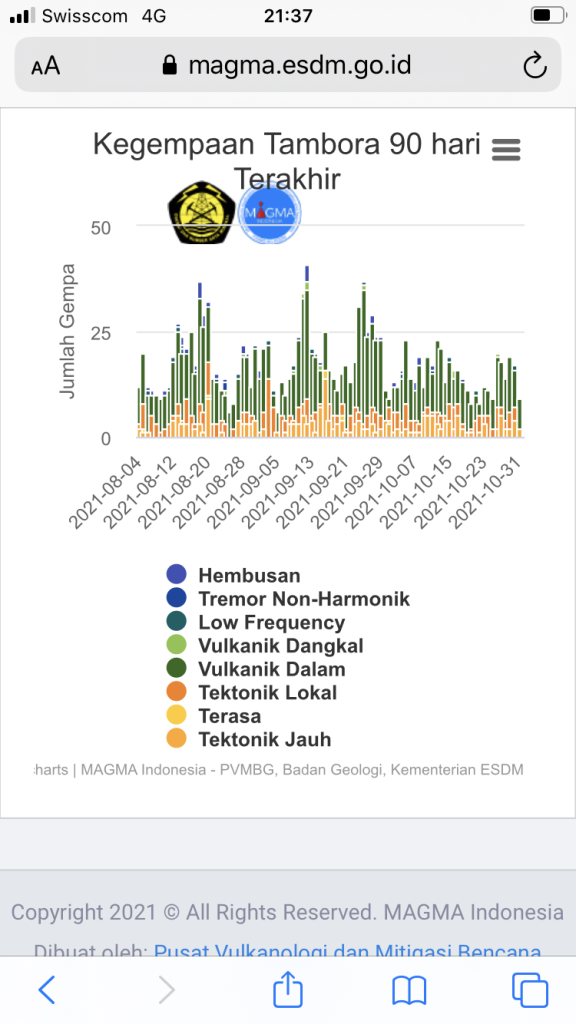
Since about 3 months now, daily volcanic tremors of different intensity have hit the the feared Tambora volcano in Indonesia.
The volcanologists are apparently not worried as the volcano remains in green status.

Of course, volcanic earthquakes can also occur without any meaning, but the interesting thing is we are talking about Tambora here. The volcano erupted catastrophically in 1815 and the VEI 7 eruption resulted in the year without summer.

The recent quakes can be an indication of pressure changes in the magma chamber (i.e., filling). It could also indicate magma intrusion into the earth’s crust, as well as a subsidence. But I would not have expected to see so many volcanic earthquakes rattling Tambora.
What are volcanic earthquakes?
For scientists, volcanic earthquakes are viewed as a sign for a potential eruption.
There are two types of volcanically generated earthquakes:
- Volcano-tectonic (VTs) earthquakes
- Long period earthquakes (LPs).
Volcanic-tectonic earthquakes (VTs)
Volcanic-tectonic earthquakes (VTs) are, simply put, caused by slip on a fault near a volcano. Volcanoes are often found in areas of crustal weakness and the mass of the volcano its self adds to the regional strain.
Most VT earthquakes have nothing to do with the magmatic system of the volcano but occur in response to regional strain exerted in an area of weak faults. VTs can also be generated from changes of pressure under the volcano caused by the injection or removal of magma (molten rock) from the volcanic system.
After the withdrawal of magma from a system, an empty space is left to be filled. The result is a collapse of surrounding rock to fill the void, also creating earthquakes.
VT earthquakes can result in land deformation, collapse and/or ground failure but they are usually small and leave no trace on the surface. While these earthquakes may cause damage, they usually don’t due to their small size which produces weak shaking.
Occasional VTs or even in a significant swarm of dozens of events do not in themselves indicate an impending eruption. However, if a significant introduction of new magma from depth occurs in the system, both VTs and long period earthquakes are likely to be generated.
Long Period earthquakes (LPs)
Volcanically-caused long period earthquakes are produced by vibrations generated by the movement of magma or other fluids within the volcano. Pressure within the system increases and the surrounding rock fails, creating small earthquakes.
These earthquakes are an indication of magmatic activity and may be a precursor to an eruption. When these earthquakes occur continuously the result is volcanic or harmonic tremor.
The volcanic tremor can be used to warn of an impending eruption allowing people living near the volcano can to be evacuated to safer areas. This method of prediction has been used successfully to predict the eruptions of Mount St. Helens in the 1980’s and the 1991 eruption of Mt. Pinatubo in the Philippines.
USGS Volcano scientists at the Cascade Volcano Observatory use information obtained from earthquake activity and patterns in combination with many other data sources from the volcano including near and far field deformation, gas emissions, geochemistry, heat transfer and more, to determine the likelihood of an eruption and to estimate how dangerous the eruption is likely to be.
So can Tambora erupt again?
In the current case, I am not sure if we are facing VTs, LPs or a mix of both. But they are more likely volcanic tectonic earthquakes and thus don’t indicate an impending eruption.
I personally consider it extremely unlikely that the Tambora would be ready for a new eruption, only 200 years after the mega blast of 1815. That eruption was so big, that many hundreds if not thousands of years would be needed for Tambora’s magma chamber to recharge for another eruption of that scale.
Even if magma is flowing into the chamber, there is by no means any reason to worry. I think these volcanic tremors are simply another sign of life for the volcano.
Now subscribe to this blog to get more amazing news curated just for you right in your inbox on a daily basis (here an example of our new newsletter).
You can also follow us on Facebook and/ or Twitter. And, by the way you can also make a donation through Paypal. Thank you!
You should really subscribe to QFiles. You will get very interesting information about strange events around the world.














Great just what we need. Lol.
Double whammy? Cumbre Vieja and Tambora — in stereo?
Great just what need. Lol.